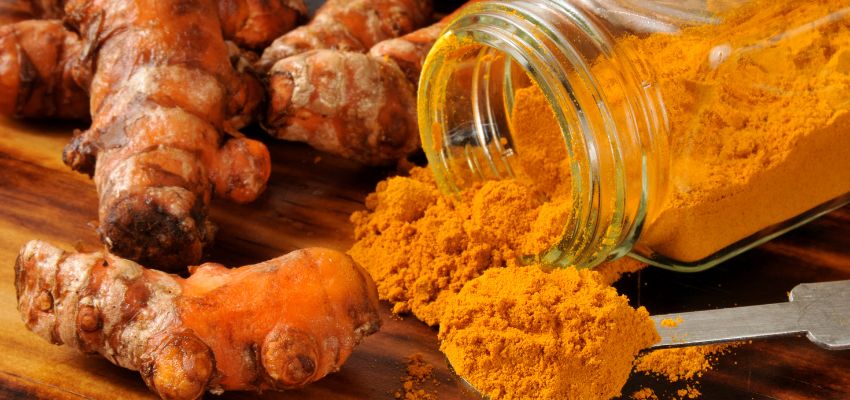Can You Rely On Turmeric For Wound Healing? Find Out Here

Published April 18, 2025
Can a simple kitchen spice speed up your recovery? With its vibrant yellow color and centuries of use in traditional medicine, turmeric is stirring up conversations about its potential benefits. But when it comes to turmeric for wound healing, does it live up to the hype or fall short? Let’s dive into the science behind this ancient remedy and uncover the truth.
In this article, we’ll explore turmeric’s science and practical uses for wound healing.
The Science Behind Turmeric And Wound Healing
Wound healing is a complex process. It includes coagulation, inflammation, tissue repair, and scar formation. Curcumin, the active ingredient found in turmeric, has been studied extensively. It shows a remarkable ability to support these key stages.
Here’s how curcumin works its magic:
Curcumin: The Healing Power Of Turmeric
Curcumin is the active compound in the rhizome of the Curcuma longa plant. It’s known for its powerful therapeutic properties. Research shows that curcumin helps with wound healing due to its strong antioxidant, antimicrobial, and anti-inflammatory effects.
These properties neutralize harmful free radicals at the wound site and control inflammation, creating the perfect environment for the body to heal naturally.
Curcumin helps produce growth factors essential for tissue regeneration. It supports the quick formation of new skin and granulation tissue. These are crucial for proper wound healing and recovery.
Anti-Inflammatory And Antimicrobial Properties
Chronic inflammation makes wound healing difficult, especially with diabetes or infections. Curcumin helps by reducing inflammation. It suppresses inflammatory molecules like cytokines. Its antimicrobial properties also fight harmful bacteria. This minimizes the likelihood of disease and supports better healing.

Practical Guide To Using Turmeric For Wound Healing
Are you curious about incorporating turmeric into wound care? With its natural healing properties, turmeric can be a simple and effective addition to your routine—when used correctly.
Here’s what you need to know.
How To Prepare And Use Turmeric Paste For Healing
Creating a topical paste is one of the most popular ways to use turmeric for wound care. Follow these easy steps:
- Mix equal parts of turmeric powder with clean water or coconut oil to form a smooth paste.
- Gently dab on a thin layer of the paste to the cleaned wound.
- Cover the area with a sterile bandage to hold the paste in place.
This turmeric paste can help reduce infection risk and soothe the wound. For the best results, be sure to reapply it daily. When used correctly, turmeric is a natural and effective aid in wound care.
Safety Tips And Precautions When Using Turmeric On Wounds
If you’re considering turmeric for wound care, follow these necessary precautions to ensure safe and effective use:
- Do a Patch Test: Before placing the turmeric paste on a wound, test a small amount on your skin for allergic reactions.
- Ensure Sterility: Use clean, uncontaminated turmeric powder and sterile mixing tools to prevent the introduction of bacteria that could worsen the wound.
- Limit to Minor Injuries: Turmeric is best suited for minor cuts and abrasions. Always consult a healthcare professional before use on deep or surgical wounds.
Is Turmeric Good For Wound Healing? Pros And Cons
Turmeric is renowned for its health benefits, but it’s not a universal solution for wound care. Here’s a closer look at its strengths and limitations.
When Turmeric Works – And When It Doesn’t
Turmeric has anti-inflammatory and antimicrobial properties. It can help treat minor, non-serious wounds. It’s a natural and affordable option for wound care.
Turmeric is not recommended for more extensive wounds or infected injuries. Avoid using it for post-surgical care unless advised by a healthcare professional. Excessive use can cause skin irritation or staining, especially for sensitive skin.
Turmeric Vs. Other Natural Remedies
Turmeric is a powerful natural remedy. It’s often compared to marigold (Calendula officinalis), another popular healing option. A study in the Journal of Advanced Veterinary and Animal Research found turmeric promotes faster wound recovery than marigold.
It boosts collagen production and stimulates epithelial tissue formation. Both are key for effective healing. Marigold paste has benefits, but turmeric’s restorative properties are unmatched.
Frequently Asked Questions
How often should I apply turmeric paste for wound healing?
It’s recommended that turmeric paste be applied once or twice a day. To ensure effective results, be sure to clean the wound thoroughly before each application.
Can I use store-bought turmeric powder for wounds?
Yes, but make sure the turmeric powder is pure and free from additives or preservatives. Organic turmeric is the safest option.
Are there any side effects of using turmeric for wound healing?
Some people might experience mild skin irritation or an allergic reaction. Always do a patch test before applying turmeric paste over a large area.
Is turmeric safe for healing surgical wounds?
Turmeric’s antibacterial properties may be beneficial, but surgical wounds require extra care. Consult your doctor before using turmeric in such cases.
Can you drink turmeric milk for wound healing?
Golden milk, a mix of turmeric powder and warm milk, is a well-loved traditional remedy for many internal health issues. Turmeric milk may help promote internal healing. Curcumin, found in turmeric, has anti-inflammatory properties. This may support the repair of wounds or surgical sites.
Is turmeric milk good for wounds internally?
Turmeric milk has anti-inflammatory effects. It can help reduce systemic inflammation. This is useful for slow-healing wounds. Turmeric drinks can support your healing process while not a direct treatment for injuries.

Natural Healing Starts Here: What Turmeric Can Do For You
Turmeric for wound healing is a promising natural remedy, thanks to its curcumin-rich composition. Its ability to lessen inflammation, promote tissue regeneration, and protect against infection makes it a great addition to your first aid kit. However, like any treatment, turmeric works best when used correctly and for appropriate types of wounds. Combining turmeric with professional medical advice ensures optimal healing and recovery for more complex injuries.
Want to experience turmeric’s powerful healing benefits? Start with your skin—AMVital’s turmeric-based skincare line is your first step toward healthier, revitalized skin. Explore the collection at amvital.com.
Unlock the Power of Turmeric With AMVital Products
Experience the transformative effects of AMVital’s meticulously formulated turmeric-infused products. Indulge in the luxurious goodness of our expertly crafted skincare and haircare range. Harness the incredible natural benefits of this golden spice and discover the remarkable power of turmeric. Explore our shop now and unlock radiant, healthier-looking skin and hair. Visit our shop to experience AMVital’s finest turmeric products.

This Content Has Been Reviewed For Factual Accuracy
The information presented here has been meticulously checked by our internal experts. To learn more about our rigorous editorial process, you can click here.

About The Author
I’m Corinne Grace, a passionate writer for AMVital.com. I create articles based on sound scientific evidence to help you make healthy decisions. As a nurse, I’ve been on the front lines, seeing the critical importance of accurate information.


